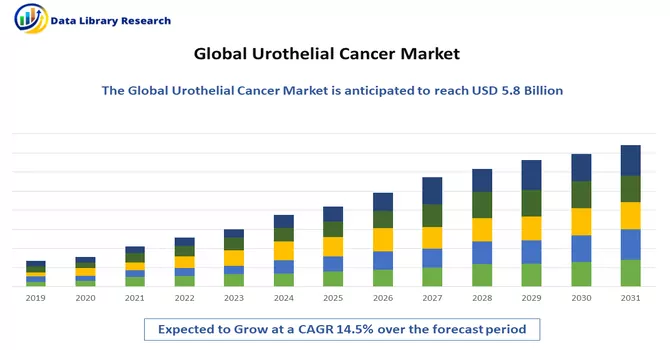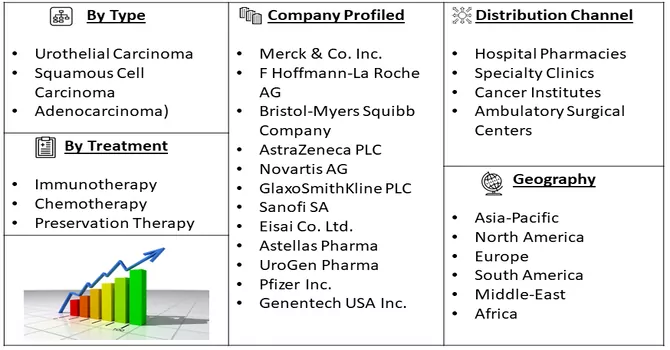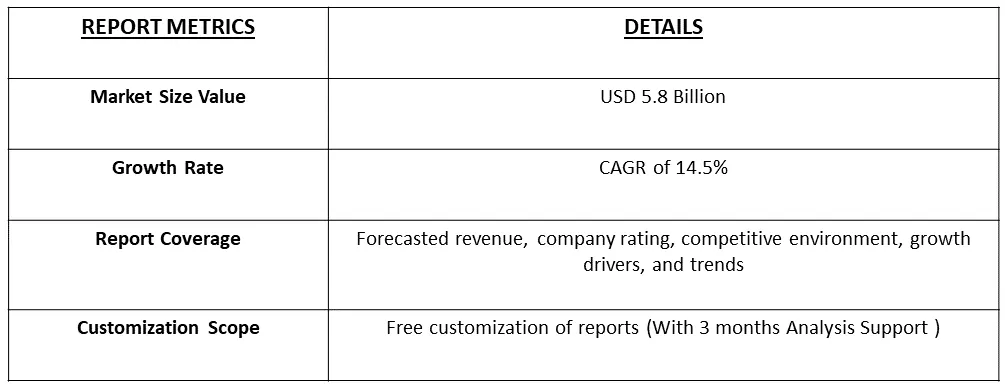The urothelial cancer drugs market studied is projected is currently valued at USD 5.8 Billion in 2023 to register a CAGR of 14.5% over the forecast period, 2023-2030.

Get Complete Analysis Of The Report - Download Free Sample PDF
Urothelial cancer, also known as transitional cell carcinoma (TCC) or urothelial carcinoma, is a type of cancer that begins in the urothelial cells. The urothelium is the innermost layer of the bladder, as well as the lining of the ureters, urethra, and renal pelvis. These are parts of the urinary system responsible for storing and transporting urine. Urothelial cancer can occur in various parts of the urinary tract, but it most commonly originates in the bladder. It can also affect the renal pelvis (the part of the kidney where urine collects before it flows into the ureter) and the ureters (tubes that carry urine from the kidneys to the bladder). The cancer arises when abnormal cells in the urothelium begin to grow and multiply uncontrollably, forming a tumour. Risk factors for urothelial cancer include smoking, exposure to certain industrial chemicals, chronic bladder irritation or inflammation, and certain genetic factors. Common symptoms of urothelial cancer include blood in the urine, changes in bladder habits, and pain during urination.
The growth and prevalence of urothelial cancer are influenced by several driving factors. Some key contributors to the dynamics of urothelial cancer include exposure to carcinogens, such as those found in tobacco smoke and certain industrial chemicals. Moreover, the availability of healthcare services and access to timely diagnostic and treatment options impact the detection and management of urothelial cancer.
The prominence of immunotherapy in the treatment of urothelial cancer, particularly immune checkpoint inhibitors like pembrolizumab and atezolizumab, demonstrating improved outcomes and changing the treatment paradigm. Furthermore, growing emphasis on personalized medicine, with the identification and utilization of biomarkers for urothelial cancer that enable targeted and more effective therapeutic interventions. The increasing exploration of combination therapies, involving a mix of immunotherapies, chemotherapy, and targeted therapies to enhance treatment efficacy and address resistance mechanisms. Thus, these trends is crucial for stakeholders in the urothelial cancer market, including healthcare professionals, pharmaceutical companies, researchers, and policymakers, as they collectively work towards advancing patient care and improving outcomes in the field of urothelial cancer.
Market Segmentation: The Urothelial Cancer Drugs Market has been segmented by Treatment (Chemotherapy and Immunotherapy) and Geography (North America, Europe, Asia Pacific, Middle East and Africa, and South America). The report offers the value (in USD million) for the above segment.

For Detailed Market Segmentation - Download Free Sample PDF
Market Drivers :
Increased Cancer Awareness
The urothelial cancer drug market is poised for significant expansion, driven by factors such as heightened awareness surrounding bladder-related conditions, increased healthcare expenditure, and a rising prevalence of bladder cancer. A notable instance of this awareness is the designation of the 'Don't Go Red' theme for Bladder Cancer Awareness in March 2022 by the World Bladder Cancer Patient Coalition. This initiative aims to amplify understanding of the warning signs and symptoms associated with bladder cancer, emphasizing the pivotal role of early detection in improving long-term survival rates and enhancing overall quality of life. The proactive promotion of such awareness campaigns contributes to a growing recognition of the importance of timely intervention and treatment options in the landscape of urothelial cancer, fostering a favorable environment for the rapid development and adoption of novel therapies within the market.
Increased Cancer Cases
Moreover, the escalating global incidence of bladder cancer is a key driver propelling the expansion of the urothelial cancer drug market throughout the forecast period. Illustratively, data from the American Cancer Society as of January 2023 projects an estimated 82,300 reported cases of bladder cancer in the United States, with 62,400 cases expected among men and 19,900 among women. This surge in bladder cancer cases underscores the growing demand for urothelial cancer drugs. Nevertheless, despite the market's positive trajectory, it is essential to acknowledge potential impediments such as the emergence of side effects associated with these drugs, which could pose challenges to sustained market growth. It highlights the importance of ongoing research and development efforts to address these concerns and optimize the risk-benefit profile of urothelial cancer drugs for enhanced patient outcomes.
Market Restraints :
Side Effects Associated with Drugs
As with many cancer treatments, the side effects associated with urothelial cancer drugs can impact patient compliance and quality of life. Management of these side effects is crucial to sustaining treatment adherence. The urothelial cancer market is dynamic, with pharmaceutical companies striving to introduce innovative therapies that not only demonstrate efficacy but also exhibit favourable safety profiles, minimizing the impact of side effects.
The COVID-19 pandemic has had a multifaceted impact on the urothelial cancer market, influencing various aspects from patient care to research and market dynamics. The pandemic prompted a revaluation of treatment plans, with considerations for minimizing hospital visits and exposure to immunocompromised patients. The pandemic accelerated the adoption of telehealth and remote monitoring technologies. As the situation evolves, ongoing efforts are crucial to mitigating the long-term impact of the COVID-19 pandemic on the urothelial cancer market, ensuring continuity of care, and advancing research and development initiatives.
Segmental Analysis :
Chemotherapy Segment is Expected to Witness Significant growth Over the Forecast Period
Chemotherapy drugs, whether employed independently or in combination, are chosen based on specific therapeutic objectives in the treatment of urothelial cancer. This form of treatment stands as the predominant therapeutic approach for impeding or decelerating the growth of urothelial cancer cells. Its mechanism involves acting systemically throughout the entire body, aiming to eliminate cancer cells and prevent their migration to distant parts of the body, away from the original tumour site. Given its status as a primary or first-line treatment for urothelial cancer, the chemotherapy segment is anticipated to experience a substantial surge during the forecast period.
This projected growth can be attributed to several factors, including the increasing adoption of chemotherapy, a rising incidence of bladder cancer, and strategic product launches by key market players. As chemotherapy continues to be a cornerstone in urothelial cancer treatment, its prominence is expected to amplify, supported by a growing awareness of its efficacy and the ongoing efforts of market leaders to introduce innovative products. llustrating the impact of chemotherapy on urothelial cancer outcomes, the National Cancer Institute reported in 2022 that a combination of two chemotherapy drugs, gemcitabine and docetaxel, was administered to patients with bladder cancer. Notably, approximately 82% of individuals who received periodic treatment with both drugs after undergoing surgery to remove their bladder tumour were still alive two years later without experiencing a recurrence of their cancer. This underscores the tangible and positive effects of chemotherapy in improving survival rates and preventing cancer relapse in urothelial cancer patients. The continued advancement and optimization of chemotherapy regimens, coupled with ongoing research and development initiatives, are poised to further enhance the efficacy and outcomes associated with this crucial therapeutic approach in the management of urothelial cancer.
North America Region is Expected to Witness Significant Growth Over the Forecast Period
The North American region is poised to assert dominance in the urothelial cancer drug market, driven by several key factors, including a significant incidence of cancer cases and ongoing approvals of new drugs. The high prevalence of cancer cases and the timely approval of innovative drugs contribute significantly to the market's growth in North America. A noteworthy example is the FDA's approval of the first gene therapy for high-risk, non-muscle-invasive bladder cancer in 2022. This approval signifies a milestone in providing healthcare professionals with cutting-edge treatment options, thereby catalyzing the expansion of the market in the region. The elevated number of bladder cancer cases in North America underscores the increasing demand for urothelial cancer drugs. According to the American Cancer Society's projections for 2023, the estimated number of new bladder cancer cases in the United States alone is approximately 82,290. This substantial disease burden within the region emphasizes the necessity for effective urothelial cancer drugs to meet the healthcare demands and address the treatment needs of cancer patients.
Additionally, Canada, a significant part of the North American region, faces its own challenges in bladder cancer. The Canadian Cancer Society estimated that in 2022, approximately 13,300 Canadians received a diagnosis of bladder cancer, with around 2,500 Canadians succumbing to the disease. This underscores a pressing need for urothelial cancer drugs to effectively treat and manage the condition, thereby contributing to the growth of the market. Thus, , North America's dominance in the urothelial cancer drug market is substantiated by a confluence of factors, including a high incidence of cancer cases, regulatory approvals for innovative therapies, and a compelling demand for advanced treatment options to address the prevalent burden of bladder cancer within the region. These dynamics collectively contribute to the ongoing growth and development of the urothelial cancer drug market in North America.

Get Complete Analysis Of The Report - Download Free Sample PDF
The urothelial cancer drug market exhibits a consolidated structure, characterized by the involvement of a limited number of companies with both global and regional operations. The competitive landscape entails an examination of several international and local firms, each holding distinct market shares. This consolidation underscores the significant influence and market presence of these key players in the urothelial cancer pharmaceutical sector, both on a global scale and within specific regions. Some of the key market players working in this domain are:
Recent Developments:
1) In April 2022, Pfizer committed a USD 25 million equity investment in Zentalis Pharmaceuticals, Inc., aiming to strengthen its global development capabilities.
2) In May 2022, Pfizer initiated a two-year research collaboration with NetVation DL Medicine, a move anticipated to propel and enhance Pfizer's research initiatives.
Q1. What was the Urothelial Cancer Market size in 2023?
As per Data Library Research the urothelial cancer drugs market studied is projected is currently valued at USD 5.8 Billion in 2023.
Q2. At what CAGR is the Urothelial Cancer market projected to grow within the forecast period?
Urothelial Cancer Market is registering a CAGR of 14.5% over the forecast period.
Q3. What segments are covered in the Urothelial Cancer Market Report?
By Treatement, End-User and Geography these segments are covered in the Urothelial Cancer Market Report.
Q4. Which region has the largest share of the Urothelial Cancer Market? What are the largest region's market size and growth rate?
North America has the largest share of the market. For detailed insights on the largest region's market size and growth rate request a sample here.
Data Library Research are conducted by industry experts who offer insight on industry structure, market segmentations technology assessment and competitive landscape (CL), and penetration, as well as on emerging trends. Their analysis is based on primary interviews (~ 80%) and secondary research (~ 20%) as well as years of professional expertise in their respective industries. Adding to this, by analysing historical trends and current market positions, our analysts predict where the market will be headed for the next five years. Furthermore, the varying trends of segment & categories geographically presented are also studied and the estimated based on the primary & secondary research.
In this particular report from the supply side Data Library Research has conducted primary surveys (interviews) with the key level executives (VP, CEO’s, Marketing Director, Business Development Manager and SOFT) of the companies that active & prominent as well as the midsized organization
FIGURE 1: DLR RESEARH PROCESS

Extensive primary research was conducted to gain a deeper insight of the market and industry performance. The analysis is based on both primary and secondary research as well as years of professional expertise in the respective industries.
In addition to analysing current and historical trends, our analysts predict where the market is headed over the next five years.
It varies by segment for these categories geographically presented in the list of market tables. Speaking about this particular report we have conducted primary surveys (interviews) with the key level executives (VP, CEO’s, Marketing Director, Business Development Manager and many more) of the major players active in the market.
Secondary ResearchSecondary research was mainly used to collect and identify information useful for the extensive, technical, market-oriented, and Friend’s study of the Global Extra Neutral Alcohol. It was also used to obtain key information about major players, market classification and segmentation according to the industry trends, geographical markets, and developments related to the market and technology perspectives. For this study, analysts have gathered information from various credible sources, such as annual reports, sec filings, journals, white papers, SOFT presentations, and company web sites.
Market Size EstimationBoth, top-down and bottom-up approaches were used to estimate and validate the size of the Global market and to estimate the size of various other dependent submarkets in the overall Extra Neutral Alcohol. The key players in the market were identified through secondary research and their market contributions in the respective geographies were determined through primary and secondary research.
Forecast Model
